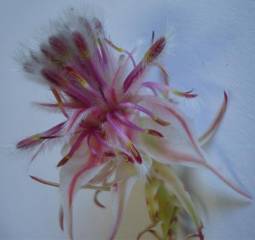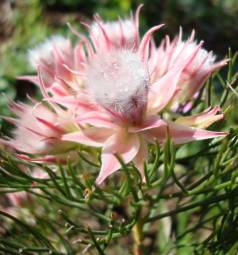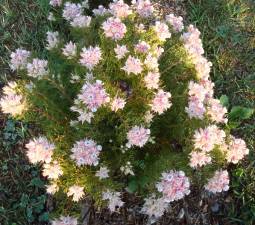Serruria rosea
Serruria rosea E.Phillips
Family: Proteaceae
Common names: rose spiderhead, bridesmaid spiderhead (Eng.); strooimeisie, bruidsbos (Afr.)
Introduction
Serruria rosea is one of the showiest spiderheads, producing a spectacular display of up to 20 rose-pink tightly clustered flower heads per stem. Plants growing at Kirstenbosch are producing upwards of 15 flowering stems and this little plant becomes a rounded flowering ball in late winter.

Description
Description
Serruria rosea is an erect shrub growing 0.8-1 m tall in the veld. In cultivation plants tend to be smaller. Leaves curve upwards and are finely divided, measuring 30-60 mm long. They are hairless and have fine points on the tips. Spherical flower heads are clustered at the ends of branches and are cream in bud, opening to rose-pink and darkening with age. Flower heads open from the tip of the branch downwards, giving a long-lasting flowering display.

The style is about 11 mm long and the pollen presenter is club-shaped. The perianth is covered with long, silver, silky hairs giving a fluffy look to the flower head. Pink involucral bracts are large, 8-25 mm long, and have a hairy margin. Flowering occurs from August-October and seeds (technically they are fruits) are released two months after flowering.
Conservation Status
Status
The rose spiderhead is classified as Near Threatened (NT) which means it does not currently qualify for any of the threat categories. Due to possible future threats from afforestation, invasive alien plants and its susceptibility to drought-related mortality it may become threatened in the not-so-distant future.
Distribution and habitat
Distribution description
Serruria rosea is a fynbos species and is restricted to the Western Cape where it is endemic to Hawequas Sandstone Fynbos. The average rainfall for this vegetation type is 1197 mm per year with most rain falling in the winter months of June, July and August. In winter the temperature does occasionally drop below freezing, with S. rosea being able to tolerate very light frosts. In summer hot, dry and often windy conditions are experienced with maximum temperatures reaching 35°C. On the mountains it grows in dense isolated stands on sandy slopes at an altitude of between 300 and 620 m.
Its natural distribution is from the Du Toitskloof to the Riviersonderend Mountains with an area of occurrence of about 51 km².

Derivation of name and historical aspects
History
Serruria was named after Dr James Serrurier who was a professor of botany at Utrecht in the early 18 th century. Rosea alludes to the rose-pink colour of the involucral bracts and flowers.
The Serruria genus contains about 55 species. They can be distinguished from other members of the Protea family by their dissected leaves which have cylindrical segments. If the flower heads are solitary they are always on the tips of branches, and if they occur in multiples they are found in the axils of the upper leaves. The closest relative to S. rosea is S. florida. They are similar in appearance but S. florida has larger white flowers, produces fewer flowering stems, and is more difficult to grow.
Spiderheads occur only in the winter rainfall fynbos region, from the Matsikamma Mountains in the north to the Cape Peninsula and to George in the east.
Ecology
Ecology
Fynbos is a fire-driven system which means the vegetation requires fire once every 10-15 years to regenerate and rejuvenate itself.
Flowers are pollinated by honey bees and a variety of beetles. After pollination seeds are produced and released where they fall to the ground. The seed has a white waxy tip at its base; this is called an elaisome and is a favourite food of indigenous ants. Ants disperse the seeds by carrying them underground to their nests where they eat off the elaisome leaving the seed in safe storage hidden away from predators like mice.
Fire moves through the fynbos in late summer killing all the mother plants of S. rosea. In early winter the rains begin and new seedlings germinate from the ant nests where they were safely protected from the fire.
Uses
Use
Serruria rosea is a stunning garden plant if given the right conditions. It hybridizes very easily with Serruria florida and hybrids have been produced for the horticultural trade.

Growing Serruria rosea
Grow
The silver pink flowers of S. rosea combine very well with shades of grey and white in the garden. Plants like Thamnochortus cinereus, Syncarpha argyropsis, Erica baueri subsp. gouriquae and Adenandra uniflora would all make good combinations.
The rose spiderhead will grow well in a fynbos garden provided you can give it the following: a well-drained sandy acidic soil that, once planted, is disturbed as little as possible, good air circulation (preferably due to wind), and direct sunlight for most of the day. If drainage is a problem in your garden try to build a slope or incorporate a rockery and plant your fynbos along it.
Serrurias will get sick and die if the environmental conditions mentioned above are not correct. Once the plants are weakened they are very prone to attack from fungi, specifically the root rot Phytophthora.
Serrurias are not long-lived plants and will require replacing every few years. One way to prolong their life is by pruning. We have found that plants grown at Kirstenbosch have remained compact and neat, due to pruning for cutting material each year. This also stimulates new growth and more flowering, as each new shoot will produce another cluster of flower heads.
Do not prune more than one-third of the bush and always make sure there is plenty of leafy growth left behind. Plants do need to be pruned from the planting stage, as pruning old plants that are already long and woody is not effective.
Watering is best done in the morning, so the plant has time to dry off before the heat of the midday sun. If plants are watered in very hot conditions the water droplets can magnify the suns rays and scorch the leaves, as well as creating ideal conditions for fungi and bacteria to grow. Applying a thick layer of mulch will keep the soil cool and moist for longer.
Serrurias do not require large amounts of feeding. Incorporate a small quantity of well-rotted compost at planting and feed twice a year with a fertilizer specifically formulated for fynbos plants.
Serruria rosea can be propagated from cuttings or seed but cuttings have a much higher success rate than seeds.
Make cuttings from December to March (summer to autumn). The cuttings should be taken from the current season's growth and measure 30-70 mm long. Dip the cuttings into a rooting hormone solution or hormone powder and plant into a medium of 50% polystyrene and 50% finely milled bark. Place in a growing house with bottom heat (25ºC) and intermittent mist. Once the roots are well developed, remove from the mist unit and harden off for three weeks. Plant the cuttings into small bags and grow on until ready to plant into the garden.
Sow seed in April when the days are warm and the nights start to cool down (late summer to autumn). Give the seed a smoke treatment. Dust the seed with a systemic fungicide. Sow on a well-drained medium consisting of 1 part loam, 1 part bark, and 2 parts sand, firm down and cover with a layer of sand or finely milled bark. Seed can be sown in a seed tray placed in a sunny position.
Germination begins after three to four weeks. Once two true leaves have grown, prick the seedlings out into small bags. Place the seedlings in a lightly shaded area with good air circulation. When plants are ± 50-100 mm tall, or after one year's growth, they can be planted into the garden. Nipping out the tips of the seedlings will encourage branching and produce a neater shrub.
The best time to place the young plants in the garden is just before the rainy season. This enables plants to establish themselves and send down deep roots before the hot, dry, summer season.
References
- Jackson, W.P.U. 1990. Origins and meanings of names of South African plant genera. U.C.T. Printing Dept., Cape Town.
- Leistner, O.A. (ed.) 2000. Seed plants of southern Africa : families and genera. Strelitzia 10. National Botanical Institute, Pretoria.
- Mucina, L., Rutherford, M.C. (eds) 2006. The vegetation of South Africa, Lesotho and Swaziland. Strelitzia 19. South African National Biodiversity Institute, Pretoria.
- Raimondo, D., Von Staden, L., Victor, J.E., Helme, N.A., Turner, R.C., Kamundi, D.A. & Manyama, P.A. (eds) 2009. Red List of South African plants. Strelitzia 25. South African National Biodiversity Institute, Pretoria.
- Sibis: SANBI's Integrated Biodiversity Information System. http://sibis.sanbi.org/
Credits
Louise Nurrish
Kirstenbosch National Botanical Garden
August 2010
Plant Attributes:
Plant Type: Shrub
SA Distribution: Western Cape
Soil type: Sandy, Loam
Flowering season: Spring, Winter
PH: Acid, Neutral
Flower colour: Pink, Cream
Aspect: Full Sun
Gardening skill: Challenging
Special Features:
Horticultural zones







Rate this article
Article well written and informative
Rate this plant
Is this an interesting plant?
Login to add your Comment
Back to topNot registered yet? Click here to register.